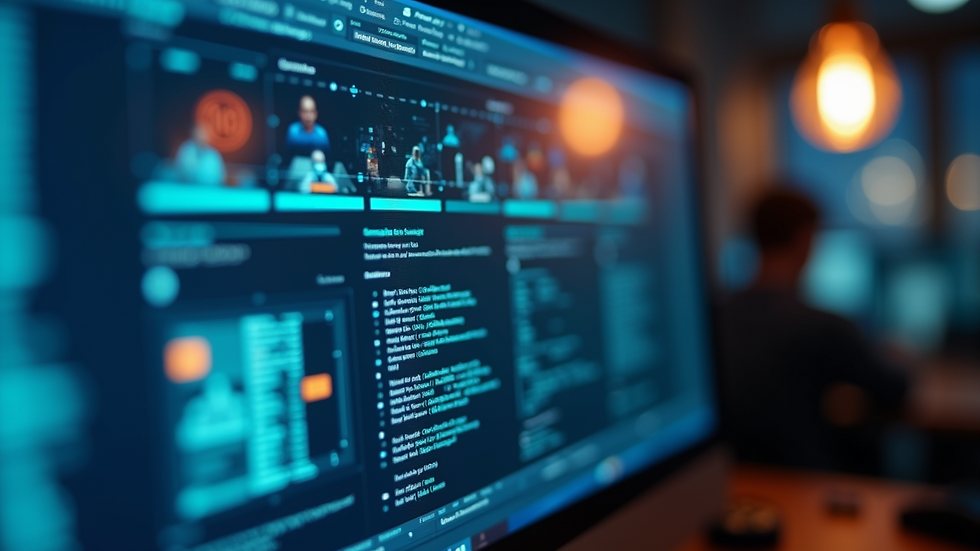The Role of Advanced Tech in Strengthening Data Security
- Ling Zhang
- May 21
- 5 min read
In today's digital landscape, data security is not just an option; it’s a necessity. With the rapid growth of technology, data breaches and cyberattacks are more common than ever. Organizations face enormous challenges in safeguarding sensitive information against increasingly sophisticated threats. Fortunately, advanced technologies are stepping in to play a pivotal role in mitigating these risks, enhancing data security measures that can protect data before it’s too late.

Understanding Data Security
Data security refers to the protective measures, tools, and policies implemented to safeguard digital information against unauthorized access, corruption, or theft throughout its entire lifecycle. This can involve various layers of security measures—from the physical hardware to the software implementations protecting the data. The goal is to ensure that only authorized users have access while keeping sensitive information confidential and intact.
Data breaches are costly and can lead to damaged reputations. According to IBM’s Cost of a Data Breach Report 2023, the average cost of a data breach is over $4 million, a figure that continues to rise annually. This underlines the need for strong data security measures in any organization.
Innovations in Data Security Technologies
As threats evolve, so do the solutions designed to combat them. Advanced technologies such as artificial intelligence (AI), machine learning, biometric authentication, and blockchain are significantly improving data security initiatives. These innovations help organizations anticipate threats and react more swiftly to incidents.
Artificial Intelligence and Threat Detection
AI technologies are transforming the way organizations handle data security. They provide advanced analytical capabilities that can spot unusual patterns and activities in real time, allowing for quicker response times. For instance, machine learning algorithms can analyze vast amounts of data to identify potential threats based on historical patterns. This is particularly useful in detecting anomalies that may signify a cyber breach, such as unfamiliar login locations or unusual data access times.
The integration of AI in cybersecurity allows businesses to automate their security processes, making it easier to maintain a secure environment without overwhelming IT staff. Specifically, AI systems can quickly learn the normal operation of a network and alert admins about any discrepancies. This proactive approach can lead organizations toward more robust preparedness in managing data security.

Which AI is Best for Cyber Security?
Choosing the right AI for enhancing cybersecurity can depend on several factors, including the specific needs of an organization, budget, and existing infrastructure. However, some popular AI technologies involve:
Darktrace - An AI cyber defense system that provides real-time threat detection and autonomous response. It acts like an immune system, learning about the network environment and identifying intrusions.
CrowdStrike - This cloud-native platform utilizes AI for endpoint security, capable of detecting threats and enhancing response capabilities across multiple devices.
IBM Watson for Cyber Security - Leveraging natural language processing, Watson can analyze data quickly and provide insights to security teams on emerging threats.
Palo Alto Networks' Cortex XDR - An AI-driven incident response platform that integrates various data sources to provide comprehensive threat intelligence.
These technologies offer scalable and effective solutions that adapt as threats change, ensuring your organization remains protected.
Enhancing Protection with Biometric Authentication
In addition to AI, biometric technologies are emerging as powerful allies in data security. By using unique biological traits such as fingerprints, facial recognition, or even voice recognition, organizations can create robust security measures.
Biometric authentication provides a higher level of security compared to traditional password methods. For instance, even if a password is compromised, accessing biometrically secured systems would still require the unique biometric data of the authorized user.
Some companies have already implemented biometric solutions in the workplace. A report from Goode Intelligence predicts that the global biometric authentication market will reach $24 billion by 2025, showcasing its rapid adoption across various industries.

Blockchain: A Game Changer in Data Integrity
Blockchain technology is another cutting-edge tool aiding data security. By its nature, blockchain creates an immutable ledger of transactions, making it nearly impossible to alter or delete recorded data without detection. This kind of transparency is crucial for industries like finance and healthcare, where data integrity is paramount.
Through smart contracts, blockchain can also automate compliance with data protection regulations, reducing the risk of human error. Organizations can use blockchain to secure sensitive transactions effectively and establish trust among users.
Developing a Holistic Security Strategy
While advanced technologies provide substantial benefits, they are just part of the equation. Organizations must also build a comprehensive cybersecurity strategy that encompasses technology, processes, and people. A few key recommendations include:
Regular security training - Employees should be trained regularly on recognizing phishing attempts and best practices in handling sensitive data.
Layered security approach - Utilize a multi-layered security strategy that incorporates multiple tools and processes to create redundancies.
Incident response planning - Establish and regularly test incident response plans to ensure that the organization can act quickly in the event of a breach.
Ongoing assessment - Regularly assess and update security protocols to keep pace with new threats and vulnerabilities.
By utilizing a holistic approach that combines advanced technologies like AI in cybersecurity with sound practices, organizations can significantly enhance their data security posture.
Future Trends in Data Security
As the digital landscape continues to evolve, several trends are emerging in data security:
Zero Trust Architecture - This model operates on the principle that no user or device, whether inside or outside the organization, should be trusted by default. Verification is required from everyone attempting to access resources.
Cloud Security Solutions - As more organizations migrate to cloud environments, securing cloud services becomes paramount. Solutions targeting cloud-specific vulnerabilities will continue to gain traction.
More Sophisticated AI Tools - AI technologies will only become more sophisticated, providing predictive security measures that can significantly reduce risks before they affect data.
Increased Regulatory Focus - With rising concerns about data privacy and security, government regulations around data protection will likely become stricter, pushing organizations to adopt better security practices.
Incorporating advanced technology into your security toolbox is crucial for effective data protection. With the rise of innovative solutions and strategies, organizations can create a robust data security environment capable of adapting to new challenges.
By integrating AI in cybersecurity and adopting preventative measures, businesses can enhance their defenses and foster long-term trust with their customers. It’s not just about having technology; it’s about knowing how to leverage it effectively to safeguard valuable data.

May you grow to your fullest in your data science & AI!
Subscribe to our data science & AI Leadership insight blog to stay updated on the latest trends and insights! Don't miss out on valuable information that can help propel your business forward.
Subscribe Grow to Your Fullest and get your Free Download
*** Please DOWLOAD the FREE document, Find your signature vision questionnaires so you use it to help you find your life vision and mission.
Tags:





Comments